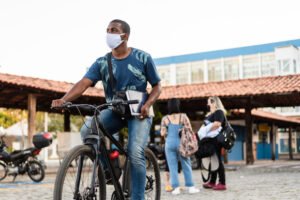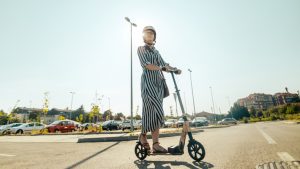 By Perry Eggleston, CAPP, DPA
By Perry Eggleston, CAPP, DPA
Rahm Emanuel said, “You never let a serious crisis go to waste. And what I mean by that it’s an opportunity to do things you think you could not do before.”
I started as executive director of UC Davis Transportation Services on January 2, 2020, and while I was still learning my way around the campus, the COVID crisis struck. The industry suddenly faced unprecedented difficulties that challenged the most senior mobility experts.
March 16 came and suddenly, there were discussions of campus closures, distance learning, and teleworking. Until that time, telework was a wish for many in the transportation industry but not considered plausible due to supervisor and management reluctance. Within a week, these discussions made campus-wide telework a reality. When this COVID thing lasted longer than a few weeks, the campus started to look at how we could use the lull to continue the momentum of flexible work arrangements (FWA–the term our campus now uses for telework and compressed work schedules), and our department pushed the campus to continue planning using them past the pandemic.
To address all the issues for making FWA an ongoing TDM strategy, I am co-chairing a university committee: “Reimagining the Workplace.” Stakeholders from human resources, technology, planning, safety and ergonomics, employee/union relations, communications, legal, and finance are all involved. The committee has already identified several advantages to FWA: recruiting the best talent, employee well-being, more campus space for students, and reducing traffic congestion and air pollution. However, there are challenges to be overcome to arrive at the advantages.
Join Ramon Zavala and me April 21 when we host the IPMI webinar, Teleworking: An Alternate Mobility Mode. We will look at what institutions should consider when creating their own FWA program and planning lessons learned.
Perry Eggleston, CAPP, DPA, is executive director, transportation services, at UC Davis. He and Ramon Zavala, the university’s transportation demand manager, will present on this topic during an IPMI webinar, April 21. Click here for details and to register.
 Read the January issue of Parking & Mobility, featuring our cover story on FHWA’s groundbreaking research on cruising and new tools to help industry professionals manage parking assets.
Read the January issue of Parking & Mobility, featuring our cover story on FHWA’s groundbreaking research on cruising and new tools to help industry professionals manage parking assets.

 “Mobility” has been used to describe everything from shared bikes and scooters to mass transit to walking to the ability of people to simply get around. If someone outside the industry asked, how would you define “mobility”?
“Mobility” has been used to describe everything from shared bikes and scooters to mass transit to walking to the ability of people to simply get around. If someone outside the industry asked, how would you define “mobility”? By Benito Pérez, CAPP; Lawrence Marcus; Alejandra Argudin, CAPP; and Michael Sawyer
By Benito Pérez, CAPP; Lawrence Marcus; Alejandra Argudin, CAPP; and Michael Sawyer By Marcía L. Alvarado, PE
By Marcía L. Alvarado, PE By Sarah Blouch, Carl DePinto, Zachary Pearce, and Keith Palma
By Sarah Blouch, Carl DePinto, Zachary Pearce, and Keith Palma By Brett Wood, CAPP, PE
By Brett Wood, CAPP, PE The City of Tucson first piloted a shared e-scooter program in fall 2019, and extended that pilot through COVID-19. Now, with micro-mobility’s popularity growing, the city is seeking growing shared mobility program.
The City of Tucson first piloted a shared e-scooter program in fall 2019, and extended that pilot through COVID-19. Now, with micro-mobility’s popularity growing, the city is seeking growing shared mobility program. Getting on a bus or train wasn’t a first choice for most during COVID-19. The thought of being in an enclosed space with more people than comfort allowed sent car sales soaring and boosted micro-mobility in cities. But with the pandemic waning and more people going back to work, school, and other destinations in person, getting people back on transit is a priority.
Getting on a bus or train wasn’t a first choice for most during COVID-19. The thought of being in an enclosed space with more people than comfort allowed sent car sales soaring and boosted micro-mobility in cities. But with the pandemic waning and more people going back to work, school, and other destinations in person, getting people back on transit is a priority. By Kevin White, CAPP, AICP
By Kevin White, CAPP, AICP By Perry Eggleston, CAPP, DPA
By Perry Eggleston, CAPP, DPA